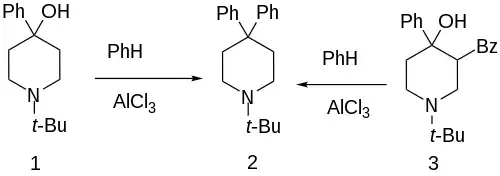Budipine
Budipine (brand name Parkinsan) is an antiparkinson agent marketed for the treatment of Parkinson's disease.[2][3][4]
 | |
| Clinical data | |
|---|---|
| AHFS/Drugs.com | International Drug Names |
| ATC code | |
| Identifiers | |
| |
| CAS Number | |
| PubChem CID | |
| ChemSpider | |
| UNII | |
| KEGG | |
| ChEMBL | |
| CompTox Dashboard (EPA) | |
| ECHA InfoCard | 100.055.494 |
| Chemical and physical data | |
| Formula | C21H27N |
| Molar mass | 293.454 g·mol−1 |
| 3D model (JSmol) | |
| |
| |
| (verify) | |
While its exact mechanism of action is not well characterized,[2] it is believed to be an NMDA receptor antagonist,[5][6] but also promoting the synthesis of dopamine.[7]
Because it provides additional benefits relative to existing treatments, it probably does not precisely mimic the mechanism of an existing known treatment.[7][8]
Synthesis
Budipine can be prepared from the 1-tert-butyl-4-piperidone [1465-76-5] directly by treatment with benzene in the presence triflic acid.[9] This method of synthesis enables a 99% yield of product.
4-Phenyl-1-t-butyl-4-piperidinol,[11] (1)
1-t-butyl-3-benzoyl-4-phenyl-4-piperidinol [81831-81-4] (3)
See also
References
- Sweetman SC, ed. (2007). Martindale: The Complete Drug Reference (35th ed.). London: Pharmaceutical Press. ISBN 978-0-85369-687-2.
- Reichmann H (October 2006). "Budipine in Parkinson's tremor". Journal of the Neurological Sciences. 248 (1–2): 53–55. doi:10.1016/j.jns.2006.05.039. PMID 16784759. S2CID 21540225.
- Przuntek H, Müller T (1999). "Clinical efficacy of budipine in Parkinson's disease". Journal of Neural Transmission. Supplementum. 56: 75–82. doi:10.1007/978-3-7091-6360-3_3. ISBN 978-3-211-83275-2. PMID 10370903.
- "Budipine". AdisInsight. Springer Nature Switzerland AG.
- Kornhuber J, Herr B, Thome J, Riederer P (1995). "The antiparkinsonian drug budipine binds to NMDA and sigma receptors in postmortem human brain tissue". Journal of Neural Transmission. Supplementum. 46: 131–137. PMID 8821048.
- Palmer GC (September 2001). "Neuroprotection by NMDA receptor antagonists in a variety of neuropathologies". Current Drug Targets. 2 (3): 241–271. doi:10.2174/1389450013348335. PMID 11554551.
- Przuntek H, Bittkau S, Bliesath H, Büttner U, Fuchs G, Glass J, et al. (May 2002). "Budipine provides additional benefit in patients with Parkinson disease receiving a stable optimum dopaminergic drug regimen". Archives of Neurology. 59 (5): 803–806. doi:10.1001/archneur.59.5.803. PMID 12020263.
- Owen JC, Whitton PS (October 2006). "Effects of amantadine and budipine on antidepressant drug-evoked changes in extracellular dopamine in the frontal cortex of freely moving rats". Brain Research. 1117 (1): 206–212. doi:10.1016/j.brainres.2006.07.039. PMID 16996043. S2CID 29177107.
- Klumpp, D. A., Garza, M., Jones, A., Mendoza, S. (1 September 1999). "Synthesis of Aryl-Substituted Piperidines by Superacid Activation of Piperidones". The Journal of Organic Chemistry. 64 (18): 6702–6705. doi:10.1021/jo990454i.
- Schaefer H, Hackmack G, Eistetter K, Krüger U, Menge HG, Klosa J (1984). "[Synthesis, physical-chemical properties and pharmacologically-oriented screening studies on budipine and related 4,4-diphenylpiperidines]". Arzneimittel-Forschung (in German). 34 (3): 233–240. PMID 6539602.
- "4-Phenyl-1-t-butyl-4-piperidinol". PubChem. U.S. National Library of Medicine. CID:20536606.
This article is issued from Wikipedia. The text is licensed under Creative Commons - Attribution - Sharealike. Additional terms may apply for the media files.
